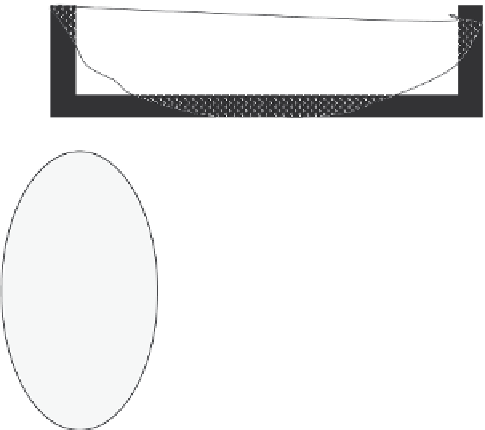Environmental Engineering Reference
In-Depth Information
Waste pile
Water impermeable cover
Natural soil base—may be
prepared as an enhanced
natural attenuation zone
Waste pile
Drainage layer
Leachate collection system
HDPE (high density polyethylene membrane)
Engineered clay barrier
Natural soil
FIGURE 3.12
Contaminant attenuation layer constructed as part of an engineered barrier system. The dimensions of the
attenuation layer and the speciication of the various elements that constitute the “ilter, membrane, and leach-
ate collection system” are generally determined by regulations or by performance criteria. (From Yong, R.N.
and Mulligan, C.N.,
Natural Attenuation of Contaminants in Soils
, CRC Press, Boca Raton, 310 pp., 2004.)
system to permit enhanced biodegradation to occur, or where catalysts are added to the
soil to permit chemical reactions to occur more effectively. ENA could include biostimula-
tion and/or bioaugmentation. These subjects are discussed in greater detail in Chapter 10.
3.4.1.5 Biostimulation
Probably the simplest procedure for improving the intrinsic bioremediation capability of a
soil is to provide a stimulus to the microorganisms that already exist in the site. This pro-
cedure is called
biostimulation
, i.e., adding nutrients and other growth substrates together
with electron donors and acceptors. The intent of biostimulation is to promote increased
microbial activity with the set of stimuli to better degrade the organic chemical contami-
nants in the soil. With the addition of nitrates, Fe(III) oxides, Mn(IV) oxides, sulfates, and
CO
2
, for example, anaerobic degradation can proceed. This technique is used for sites con-
taminated with organic chemical contaminants and is perhaps one of the least intrusive
of the methods of enhancement of natural attenuation. The other method of enhancement
that falls in the same class of “less-intrusive” enhancement procedure is bioaugmentation.
3.4.1.6 Bioaugmentation
If the native or indigenous microbial population is not capable of degrading the organic
chemicals in the soil, for whatever reason, e.g., concentrations, inappropriate consortia,
other microorganisms can be introduced into the soil. These are called exogenous






















Search WWH ::

Custom Search